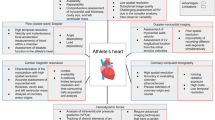Abstract
After regular and prolonged training, some physical and structural changes occur in the heart. Strain (S) imaging and Strain Rate (SR) imaging are new and effective techniques derived from tissue Doppler imaging (TDI) which examine systolic and diastolic functions. The aim of the present study was to evaluate left ventricular TDI and S/SR imaging properties in athletes and sedentary controls. The study population consisted of 26 highly trained athletes (group I) and age, sex and body mass index (BMI) adjusted 23 control subjects (group II) who had no pathological conditions. Using standard transthoracic and Doppler echocardiographical measurements and reconstructed spectral pulsed wave tissue Doppler velocities, the S/SR imaging of six different myocardial regions were evaluated. There was a significant increase in left ventricular systolic (LVSD) and diastolic (LVDD) diameter, inter-ventricular septum (IVS), left ventricular mass (LVm), left atrial diameter (LA), and transmitral Doppler peak E velocity (flow velocity in early diastole) between group I and group II in the case of echocardiographic findings. In athletes, TDI analysis showed a significantly increased mitral annulus lateral TDI peak early diastolic (E) velocity (18.8 ± 4.1 cm/s vs. 15 ± 3.5 cm/s, P < 0.01), septal TDI peak E velocity (15.8 ± 2.8 cm/s vs. 12.8 ± 2.4 P < 0.001). There were no significant differences in myocardial velocity imaging parameters between group I and group II. Peak systolic strain/strain rates of septal and lateral walls in group I were significantly higher than group II. This study demonstrates that left ventricular S/SR imaging was higher in athletes than in healthy subjects. In addition to traditional echocardiographic parameters, SI/SRI could be utilised as a useful echocardiographic method for cardiac functions of athletes.
Similar content being viewed by others
References
Maron BJ (1986) Structural features of the athlete heart as defined by echocardiography. J Am Coll Cardiol 7:190–203
Fagard RH (1996) Athlete’s heart: a meta-analysis of the echocardiographic experience. Int J Sports Med 17(suppl 3):S140–S144
Fagard R (2003) Athlete’s heart. Heart 89:1455–1461
Lewis JF, Spirito P, Pelliccia A, Maron BJ (1992) Usefulness of Doppler echocardiographic assessment of diastolic filling in distinguishing “athlete’s heart” from hypertrophic cardiomyopathy. Br Heart J 68:296–300
Cardim N, Cordeiro R, Correia MJ, Gomes E, Longo S, Ferreira T et al (2002) Tissue Doppler imaging and long axis left ventricular function: hypertrophic cardiomyopathy versus athlete’s heart. Rev Port Cardiol 21:679–707
Fisman EZ, Embon P, Pines A, Tenenbaum A, Drory Y, Shapira I et al (1997) Comparison of left ventricular function using isometric exercise Doppler echocardiography in competitive runners and weightlifters versus sedentary individuals. Am J Cardiol 79:355–359
Huonker M, König D, Keul J (1996) Assessment of left ventricular dimensions and functions in athletes and sedentary subjects at rest and during exercise using echocardiography, Doppler sonography and radionuclide ventriculography. Int J Sports Med 17(suppl 3):S173–S179
Voigt JU, Flachskampf FA (2004) Strain and strain rate. New and clinically relevant echo parameters of regional myocardial function. Z Kardiol 93:249–258
Perk G, Tunick PA, Kronzon I (2007) Non-Doppler two-dimensional strain imaging by echocardiography from technical considerations to clinical applications. J Am Soc Echo cardiogr 20:234–243
Sahn DJ, DeMaria A, Kisslo J, Weyman A (1978) Recommendations regarding quantitation in M-mode echocardiography: results of a survey of echocardiographic measurements. Circulation 58:1072–1083
Lang RM, Bierig M, Devereux RB, Flachkampf FA, Foster E, Pellikka PA et al (2006) Recommendations for chamber quantification. Eur J Echocardiogr 7:79–108
Nagueh SF, Middleton KJ, Kopelen HA, Zoghbi WA, Quiñones MA (1997) Doppler tissue imaging: a new noninvasive technique for evaluation of left ventricular relaxation and estimation of filling pressure. J Am Coll Cardiol 30:1527–1533
Pelliccia A (2000) Athlete’s heart and hypertrophic cardiomyopathy. Curr Cardiol Rep 2:166–171
Pluim BM, Zwinderman AH, van der Laarse A, van der Wall EE (2000) The athlete’s heart. A meta-analysis of cardiac structure and function. Circulation 101:336–344
Nishimura RA, Housmans PR, Hatle LK, Tajik AJ (1989) Assessment of diastolic function of the heart: background and current applications of Doppler echocardiography, part 1: physiologic and pathophysiologic features. Mayo Clin Proc 64:71–81
D’hooge J, Heimdal A, Jamal F, Kukulski T, Bijnens B, Rademakers F et al (2000) Regional strain and strain rate measurements by cardiac ultrasound: principles, implementation and limitations. Eur J Echocardiogr 1:154–170
Greenberg LN, Firstenberg MS, Castro PL, Main M, Travaglini A, Odabashian JA et al (2002) Doppler-derived myocardial systolic strain rate is a strong index of left ventricular contractility. Circulation 105:99–105
Hashimoto I, Li X, Hejmadi Bhat A, Jones M, Zetts AD, Sahn DJ (2003) Myocardial strain rate is a superior method for evaluation of left ventricular subendocardial function compared with tissue Doppler imaging. J Am Coll Cardiol 42:1574–1583
Sutherland GR, Salvo GD, Claus P, D’hooge J, Bijnens B (2004) Strain and strain rate imaging: a new clinical approach to quantifying regional myocardial function. J Am Soc Echocardiogr 17:788–803
Kato TS, Noda A, Izawa H, Yamada A, Obata K, Nagata K et al (2004) Discrimination of nonobstructive hypertrophic cardiomyopathy from hypertensive left ventricular hypertrophy on the basis of strain rate imaging by tissue Doppler ultrasonography. Circulation 110:3808–3814
Tümüklü MM, Etikan I, Cinar CS (2008) Left ventricular function in professional football players evaluated by tissue Doppler imaging and strain imaging. Int J Cardiovasc Imaging 24:25–35
Slordahl SA, Bjaerum S, Amundsen BH, Stoylen A, Heimdal A, Rabben SI et al (2001) High frame rate strain rate imaging of the interventricular septum in healthy subjects. Eur J Ultrasound 14:149–155
Author information
Authors and Affiliations
Corresponding author
Rights and permissions
About this article
Cite this article
Simsek, Z., Gundogdu, F., Alpaydin, S. et al. Analysis of athletes’ heart by tissue Doppler and strain/strain rate imaging. Int J Cardiovasc Imaging 27, 105–111 (2011). https://doi.org/10.1007/s10554-010-9669-1
Received:
Accepted:
Published:
Issue Date:
DOI: https://doi.org/10.1007/s10554-010-9669-1




